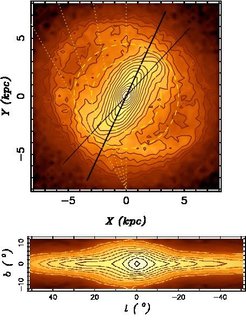Unifying a boxy bulge and planar long bar in the Milky Way
Inma Martinez-Valpuesta & Ortwin Gerhard, 2011, ApJL, 734, 20 (to the paper)
We have known for sometime that the Milky Way is a barred disk galaxy. But more recently, several studies inferred from star count observations that the Galaxy must contain a separate, new, flat long bar component, twisted relative to the barred bulge. With a simulation we showed that these observations can be reproduced with a single boxy bulge and bar structure. In this simulation, a stellar bar evolved from the disk, and the boxy bulge originated from it through secular evolution and the buckling instability.
We calculated the star count distributions for this model at different longitudes and latitudes, in a similar way as observers have done for resolved star counts. We found good quantitative agreement with the observations for a suitable model snapshot. The long bar signature in this model is partially is due to a volume effect in the star counts, and partially because of choosing a snapshot in which the planar bar has developed leading ends by interacting with the nearby spiral arm heads. We also calculated radial velocity predictions from this model for comparison with upcoming surveys.

Location of the star count maxima in the Galactic plane, for fields near the disk plane (black) and in the boxy bulge (pink). The top panel shows the maxima for the model with leading curved ends of the bar. The lower panel is for a model with straight bar ends. The thick solid line shows the true orientation of the model.

Top panel: Face-on view of the simulation with bar rotating clockwise and its ends bend towards the leading side. Lower panel: edge-on view of the same snapshot, as viewed from the Sun. The boxy structure is noticeable.

